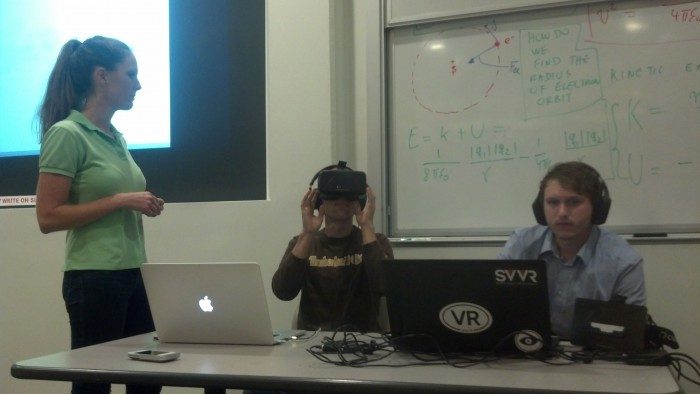
After Ryan’s talk, demonstrations of all the virtual reality demos in the room where tried out as members from the virtual reality company known as Otherworld Interactive spoke about what they have developed.
The team consists of three people: Michael Murdock (Creative Director), Robyn Gray (Chief Designer), and Andy Goldstein (Executive Producer).
Michael Murdock opened by describing the overview of the company and what properties of virtual reality are already here that enable people to tell different types of immersive stories.
Otherworld Interactive history started at the beginning of the summer of 2014 right after the team finished up an interactive media course at USC. This is the same college that Oculus’s founder Palmer Luckey spun out of. Michael and the rest of the Otherworld Interactive team saw virtual reality as an emerging technology and wanted to be a part of it. They then founded their company and started making content for VR.
The backgrounds of each of the members shows that Otherworld Interactive has a strong grasp on where VR has been, where it is now, and where it is going. Michael Murdock for instance has been involved in visual effects, animation, and motion graphics for film and television before coming to the VR space.
While working at Microsoft Research, Michael dabbled in augmented reality and projection mapping technology. From there, he joined Oculus in early 2014 as an Interactive Designer and Contractor while finishing up his Masters in Fine Arts. His user interface designs and work made its way into the Samsung Gear VR headset, rumoured to make it’s way to market in December this year.
Andy Goldstein has worked on various Perceptual Computing platforms (including one at Intel), and Robyn Gray was a research assistant at the MxR Lab at USC. Each individual understands the potential that is virtual reality, and together they are a force to be reckoned within the VR creative space.
One of their experiences, Café Âme, is set in Paris, France sometime in the 1950s at a coffee shop. Rain outside trickles down as the neon glow of business signs across the street reflect their light into the puddles below. The inside of the shop is quiet and looking at the table shows a freshly brewed cup of coffee sitting on a rounded table. There are notes scribbled across loose leaves of paper. A pen lays dormant waiting to be picked up and used.

The focus of the Café Âme project was to experiment with what it means to be comfortable in VR. Crisp, detailed ambience and viewer embodiment helped draw a spectacular scene where one can wiggle around in.
Other examples by Otherworld Interactive include an interactive music visualization called the “Garden” and an exploration of the International Space Station during a demonstration known as “Space Walk.” They also got a horror simulation for mobile phones called “Sisters” which allows people to peer into an ominous room where terror unfolds from every angle.
People in the audience at the Long Beach VR meetup consisted of members of the virtual reality community from all over. Ivan Blaustein, a co-founder of OCVR, flew down from Seattle for GDC Next and stopped by to check things out. Michel Haddad, another co-founder of OCVR, was there. In addition, OCVR members Aaron Gutierrez (who looks to have helped set up LBVR), David Green, and Andy Johnson showed up too. All of them have been actively participating in hackathons in Orange County and are now helping to spread the movement to other cities.
Jessica Ward, who is one of the co-founders of the very popular meetup known as VRLA, was in attendance as well. She brought with her a friend named Julian Volyn. Volyn is Chief of Product at a company called Trinity VR. They make the Trinity Magnum, a controller that uses optical tracking, built for use with VR games and experiences.
See also: Trinity Magnum Interview and Hands-on
Overall, the 1st Long Beach meetup was a success. It brought together active community members from all over the west coast and established itself in the Southern California VR movement. With access to demos provided by nearby developers, Long Beach residents can experience virtual reality demonstrations on their doorstep.
Upcoming meetups for LBVR are rumoured to include talks by Nonny de la Peña who is working on a couple of immersive journalism projects that bring people into re-created real life experiences. People from Wemo Lab have also been reached out to as well; so keep an eye out for what LBVR does next!
To learn more about Long Beach VR’s events, check out their meetup page online. You can also follow them on Twitter @VRLongBeach to get an inside look into what (and who) they are involved with.






